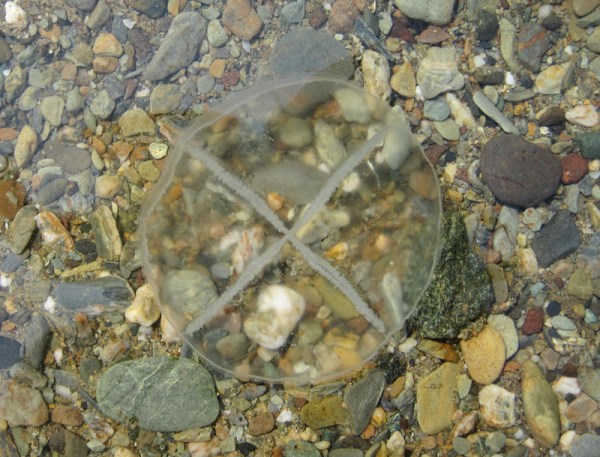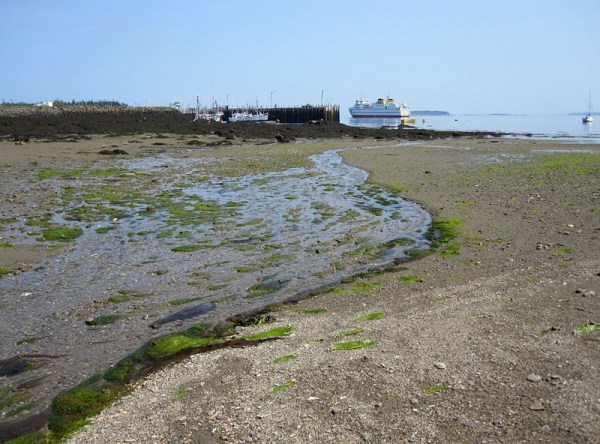White Cross Breakdown
Grand Manan Island: July, 2015

A living Staurophora mertensii over gravel in shallow water: the “white cross” represents canals and gonads.
Jellyfish are known for being short-lived. Not far from a jelly bloom where uncountable medusae swim and pulse, you might expect to find numbers of dead and dying jellyfish. In the case of the jelly bloom in North Head harbour this past summer, weakened and dying jellies were washing up nearby along the shore of Flagg’s Cove. On one unusually warm Saturday afternoon, so warm that it was pleasant to wade in the Bay of Fundy, I spent some time documenting the breakdown of white cross jellies, Staurophora mertensii. The images below show the generalized series of stages, from the living jelly to its near disappearance (this transition doesn’t take long!). As usual, my long-suffering family was remarkably tolerant of my slightly obsessive jelly observing.
Why should I want to know what happens to white cross jellies when they die and decompose? For several years, I have been working on a detailed study of fossil jellyfish from the William Lake site in central Manitoba. Those jellies, which were alive some 445 million years ago, were hydromedusan cnidarians very similar to Staurophora. By carefully examining and documenting the jellies at Flagg’s Cove, I improved my understanding of the fossil jellies at William Lake, and of the processes they had passed through during fossilization. This will contribute to the interpretation of those fossils, as we work toward their scientific publication.
Of course, observing these modern jellies can’t tell us everything we might need to know to understand the fossils. These Grand Manan examples were breaking down largely as a result of the effects of water flow and of drying in the July sun. In places like muddy tidal flats, jellyfish may be affected more strongly by bacterial decomposition, which might not be such a big factor on this gravelly temperate shore. The fossil jellies I am studying were preserved in tropical carbonate muds, quite a different sort of environment. Still, some of the parallels are striking.

When muscles contract, a white cross jelly takes a much more quadrate shape. This can also be seen in some dead jellies, suggesting that they were pulsing and contracting as they died.

Many of the beached jellies are near one or two large channels/creeks along the beach. They were probably pushed into these areas by tidal currents.

This example is nearing the end of its breakdown; any further than this and the jelly will no longer be recognizable. It will just be a bit of “scum” on the beach, which will dissolve away at the next high tide.
© Graham Young, 2015













WOW! That was great Grahm. Wish I would have spotted them when I was in the Bay of Fundy over 40 years ago. Thanks so much – we need more people to get into the finer details of events like this.
Sam, many thanks. Yes, I think it is essential for paleontologists to spend a lot more time looking at what happens in the present day.
Hi Graham. Countless millions of them must perish this way… I wonder what the mathematical stats are on the ones that are buried in the “right type” of mud for fossilization? One out of a million….5 million, 10 million etc.
You are in the business of “rarity.”
Thanks always
Steve, thanks for your comment. Sorry I hadn’t replied, but I seem to have been too busy for blogging in the past while!